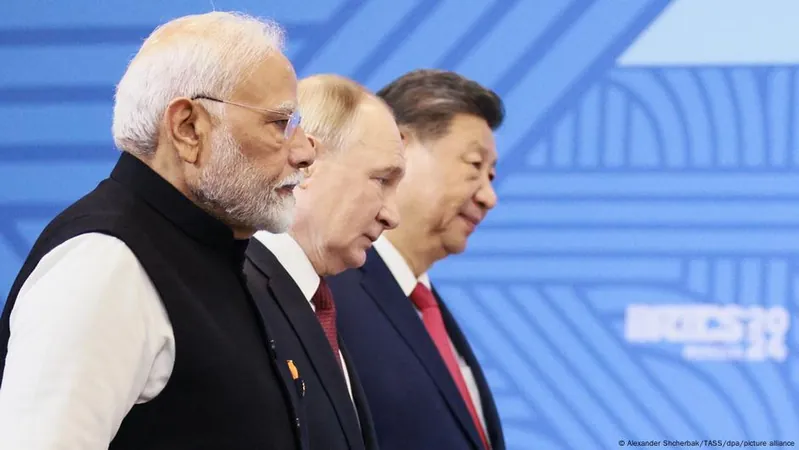
Will BRICS Flourish on Trump's Watch?
2025-08-27
Author: Ling
Donald Trump’s presidency might be unwittingly binding the BRICS nations closer than ever, as his aggressive tariff policies target these emerging economies, imposing heavier burdens than on other countries.
With China facing a staggering 145% tariff unless a deal is struck, Brazil and India are not far behind, slapped with a 50% tariff—driven partially by India's purchase of discounted Russian oil. South Africa sees a 30% levy, while newer member Egypt might also be affected due to its BRICS affiliation.
Throughout his second term, Trump has wielded threats of further punitive actions against nations he accuses of anti-American policies, hinting strongly at BRICS' rising challenge to U.S. hegemony.
A Unifying Force?
However, former Indian trade official Ajay Srivastava argues that Trump’s tariffs have inadvertently unified the BRICS nations. He believes they are motivated to reduce their dependency on the U.S., which, despite their differing agendas, creates a shared grievance and incentive.
As a result, BRICS members are expanding bilateral trade agreements in their national currencies, aiming to lessen their reliance on the U.S. dollar. Central banks are even increasing gold purchases to signal intentions to dedollarize.
Critics suggest that Trump’s assertion that "BRICS is dead" might be remarkably shortsighted. A foreign policy expert from the Council on Foreign Relations, Max Boot, contends that Trump’s actions have brought together diverse countries with contrasting objectives into a more cohesive bloc, dangerously aligning them closer to rivals like China and Russia.
A Show of Solidarity Coming Up
Upcoming at the Shanghai Cooperation Organization summit in Tianjin, China, leaders including Xi Jinping, Narendra Modi, and Vladimir Putin will manifest this newfound solidarity. This marks Modi's first visit to China in seven years, adding further significance.
With Russia advocating for high-level talks among the three primary BRICS powers, the move is seen as a strategy to ease historical tensions—especially between India and China—and to present a united front against Western influence.
India’s Shift in Strategy
As a direct impact of Trump’s tariffs, India has rekindled its economic ties with China, reinstating direct flights and fostering trade discussions. Talks to address long-standing border disputes along their massive shared border have also resumed.
Recently, agreements were established to enhance the supply of critical rare earth minerals from China, essential for India's green technology initiatives.
Nevertheless, skepticism lingers over the durability of these ties, given India's unease about China's relationships with its rivals and economic competition.
Brazil and South Africa on the Rise
Meanwhile, Brazil is also strengthening its trade relations with China, which comprises 26% of its exports, in a move that highlights the shifting balances of power within BRICS.
South Africa remains resolute in its BRICS commitments, demonstrating its intention to pursue global governance reforms and economic exchanges despite U.S. pressures.
Divergent Paths Ahead
As BRICS evolves, with Saudi Arabia considering its membership, the group faces notable challenges stemming from varied national priorities. Former official Srivastava notes that BRICS is becoming less about complete unity and more focused on pragmatic cooperation across trade and finance.
Intra-BRICS trade is booming faster than trade with G7 countries, yet it still faces significant barriers compared to trade relations in the Global North. Despite obstacles, signs point to increasing cooperation and potential for forming a BRICS-wide free trade agreement.
Looking into the Future
Experts foresee a heightened urgency in intra-BRICS trade initiatives, with a potential for 'Buy BRICS' campaigns and new projects aimed at enhancing local currency settlements.
Though a proposal for a unified BRICS currency remains stagnant, the future will likely see a complex blend of overlapping financial networks rather than a singular system. Experts predict the dollar's dominance will continue, but alternative currencies like the yuan, rupee, and ruble will gradually chip away at its supremacy.





 Brasil (PT)
Brasil (PT)
 Canada (EN)
Canada (EN)
 Chile (ES)
Chile (ES)
 Česko (CS)
Česko (CS)
 대한민국 (KO)
대한민국 (KO)
 España (ES)
España (ES)
 France (FR)
France (FR)
 Hong Kong (EN)
Hong Kong (EN)
 Italia (IT)
Italia (IT)
 日本 (JA)
日本 (JA)
 Magyarország (HU)
Magyarország (HU)
 Norge (NO)
Norge (NO)
 Polska (PL)
Polska (PL)
 Schweiz (DE)
Schweiz (DE)
 Singapore (EN)
Singapore (EN)
 Sverige (SV)
Sverige (SV)
 Suomi (FI)
Suomi (FI)
 Türkiye (TR)
Türkiye (TR)
 الإمارات العربية المتحدة (AR)
الإمارات العربية المتحدة (AR)